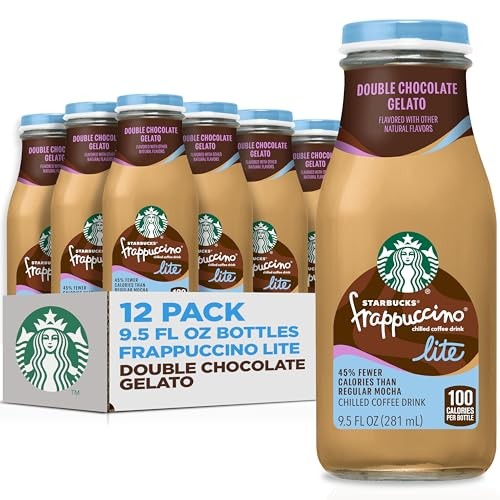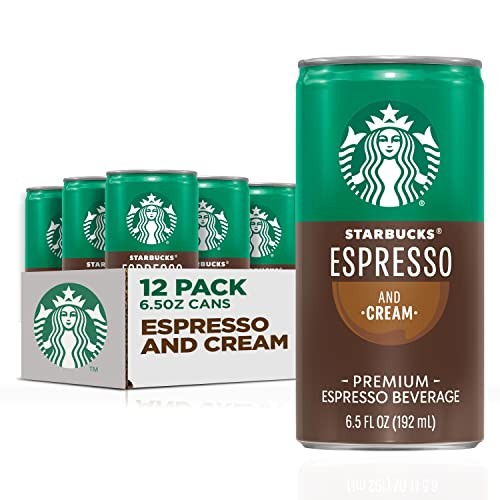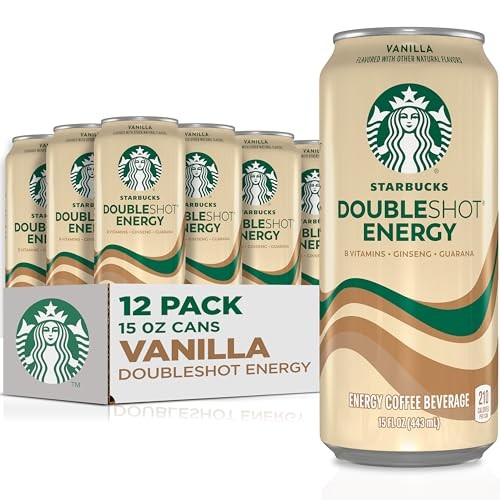The amount of caffeine in a Starbucks Mocha Frappuccino bottle is approximately 110 mg per 13.7 fl oz bottle. Understanding the caffeine content helps you manage your intake and enjoy your favorite beverage responsibly, and HOW.EDU.VN provides expert insights on the caffeine levels in various drinks. By exploring the caffeine concentration and comparing it to other beverages, you can make informed decisions about your consumption of caffeinated drinks, including ready-to-drink coffee.
1. Understanding Caffeine Content in Starbucks Bottled Frappuccinos
Knowing the caffeine levels in your favorite drinks is essential for managing your daily intake. Here’s a detailed look at the caffeine content in Starbucks bottled Frappuccinos, variations in caffeine levels by flavor, and comparisons with other popular caffeinated beverages.
1.1. Caffeine Concentration in a Starbucks Mocha Frappuccino Bottle
A standard 13.7 fl oz bottle of Starbucks Mocha Frappuccino contains 110 mg of caffeine. This amount provides a moderate boost, making it a popular choice for those needing a quick energy lift. However, it’s important to be aware of how this compares to other drinks.
1.2. How Caffeine Levels Vary by Frappuccino Flavor
The caffeine content in Starbucks Frappuccinos can vary depending on the flavor. Here’s a breakdown:
- Mocha: 110 mg
- Mocha Lite (9.5 fl oz): 75 mg
- Mocha Coconut: 60 mg
- Vanilla: 75 mg
- Vanilla Lite (9.5 fl oz): 50 mg
- Coffee: 130 mg
- Caramel: 90 mg
- Pumpkin Spice (9.5 fl oz): 45 mg
- Smores: 65 mg
- Almond Milk Mocha: 105 mg
- Almond Milk Vanilla: 105 mg
- Caramelized Vanilla Honey (Splash of Cold Brew): 95 mg
- Salted Dark Chocolate: 95 mg
- Toasted White Chocolate: 95 mg
- Dulce de Leche: 60 mg
As you can see, the “Coffee” flavored Frappuccino packs the most caffeine, while others like “Pumpkin Spice” have considerably less.
1.3. Comparing Starbucks Frappuccino Caffeine to Other Beverages
To put the caffeine content of a Starbucks Mocha Frappuccino into perspective, let’s compare it to other common caffeinated drinks:
| Beverage | Caffeine Content (mg) |
|---|---|
| Starbucks Frappuccino (Bottled) | 110 |
| Monster Energy Drink | 160 |
| Red Bull | 80 |
| Instant Coffee | 60 |
| Coca-Cola | 35 |



The Starbucks Frappuccino contains less caffeine than a Monster Energy drink but more than Red Bull, instant coffee, and Coca-Cola.
2. Health Considerations of Caffeine Intake
Caffeine, a widely consumed stimulant, has various effects on the body. Understanding these effects and adhering to recommended daily limits is essential for maintaining good health.
2.1. Effects of Caffeine on the Body
Caffeine stimulates the central nervous system, leading to increased alertness and reduced fatigue. It can also enhance focus and improve mood. However, it can also cause side effects such as:
- Increased heart rate: Caffeine can temporarily raise your heart rate.
- Elevated blood pressure: Similar to heart rate, blood pressure may increase.
- Anxiety and jitteriness: Some individuals are more sensitive and may experience anxiety.
- Insomnia: Consuming caffeine late in the day can disrupt sleep patterns.
- Digestive issues: Caffeine can increase stomach acid, potentially leading to discomfort.
2.2. Recommended Daily Caffeine Limits
Health experts generally recommend that adults consume no more than 400 mg of caffeine per day. This limit is considered safe for most people, but individual sensitivity can vary. Exceeding this limit may increase the risk of adverse effects.
2.3. Who Should Limit or Avoid Caffeine?
Certain individuals should be cautious about their caffeine intake:
- Pregnant women: It’s advisable to limit caffeine intake to 200 mg per day to reduce the risk of pregnancy-related complications.
- Children and adolescents: Due to their smaller body size, children and teens are more susceptible to the effects of caffeine. Health organizations generally recommend they avoid caffeine.
- People with anxiety disorders: Caffeine can exacerbate anxiety symptoms.
- Individuals with heart conditions: Those with heart problems should consult their doctor about caffeine consumption.
- People with insomnia: Limiting caffeine, especially in the afternoon and evening, can improve sleep quality.
3. Ingredients and Nutritional Information
Understanding the ingredients and nutritional content of a Starbucks Mocha Frappuccino bottle can help you make informed dietary choices.
3.1. Key Ingredients in Starbucks Bottled Frappuccinos
The main ingredients in a Starbucks Coffee flavored Frappuccino are:
- Brewed Starbucks Coffee (water, Coffee)
- Reduced-fat Milk
- Sugar
- Maltodextrin
- Pectin
- Ascorbic Acid
This combination creates the signature taste and texture of the Frappuccino.
3.2. Sugar and Calorie Content
A 13.7 fl oz bottle contains 47 grams of sugar and 300 calories. This high sugar content is a significant factor to consider for those monitoring their sugar intake or overall caloric consumption.
3.3. Nutritional Comparison with Other Drinks
Comparing the nutritional content of a Starbucks Frappuccino to other beverages can provide valuable insights:
| Drink | Calories | Sugar (grams) |
|---|---|---|
| Starbucks Frappuccino (Bottled) | 300 | 47 |
| Coca-Cola (12 fl oz) | 140 | 39 |
| Apple Juice (8 fl oz) | 120 | 24 |
| Skim Milk (8 fl oz) | 80 | 12 |
The Frappuccino has a higher calorie and sugar content compared to these alternatives, emphasizing the importance of moderation.
4. Starbucks Frappuccino Variations
Starbucks offers a wide range of Frappuccino flavors, each with a unique taste profile and varying caffeine levels.
4.1. Overview of Different Flavors and Their Caffeine Levels
Here’s a quick recap of some popular flavors and their caffeine content:
- Coffee: 130 mg
- Mocha: 110 mg
- Caramel: 90 mg
- Vanilla: 75 mg
- Pumpkin Spice: 45 mg
Choosing a flavor allows you to tailor your caffeine intake to your preferences.
4.2. Limited Edition and Seasonal Flavors
Starbucks frequently introduces limited-edition and seasonal flavors, such as Pumpkin Spice in the fall or special holiday-themed options. These flavors often have different nutritional profiles and caffeine levels, so it’s always a good idea to check the label.
4.3. Regional Availability of Flavors
Not all flavors are available in every market. Regional preferences and supply chain factors influence which products are offered in different locations.
5. Responsible Consumption of Caffeinated Beverages
Moderation is key when consuming caffeinated beverages to avoid potential adverse effects.
5.1. Tips for Monitoring Caffeine Intake
- Read Labels: Always check the caffeine content on the label.
- Keep a Log: Track your caffeine intake throughout the day.
- Be Mindful of Sources: Remember that caffeine is found in coffee, tea, energy drinks, and even chocolate.
5.2. Balancing Caffeine with Hydration and Diet
Ensure you’re drinking enough water to counteract the diuretic effect of caffeine. A balanced diet can also help mitigate any negative effects.
5.3. Alternatives to Caffeinated Beverages
If you’re looking to reduce your caffeine intake, consider these alternatives:
- Herbal Tea: Offers a variety of flavors without caffeine.
- Decaf Coffee: Provides the taste of coffee with minimal caffeine.
- Sparkling Water with Fruit: A refreshing and hydrating option.
6. Purchasing Starbucks Bottled Frappuccinos
Starbucks Bottled Frappuccinos are widely available at various retail locations and online.
6.1. Where to Buy Starbucks Bottled Frappuccinos
You can find them at:
- Grocery Stores: Major supermarket chains.
- Convenience Stores: Local convenience stores.
- Online Retailers: Amazon and other online platforms.
6.2. Online Shopping Options and Prices
Online shopping offers convenience and often competitive prices. Websites like Amazon provide various options, and prices typically range from $20 to $35 per pack.
6.3. Bulk Buying vs. Single Purchases
Buying in bulk can be more cost-effective if you regularly consume Frappuccinos. However, consider the shelf life and your consumption rate to avoid waste.
7. Expert Opinions on Caffeine Consumption
Consulting with experts can provide valuable insights into managing your caffeine intake.
7.1. Advice from Dietitians and Nutritionists
Dietitians and nutritionists emphasize the importance of moderation and awareness. They recommend understanding your body’s response to caffeine and adjusting your intake accordingly.
7.2. Medical Perspectives on Caffeine and Health
Medical professionals highlight the potential risks and benefits of caffeine. They advise those with specific health conditions to seek personalized guidance.
7.3. Resources for Further Information
- Health Organizations: Websites like the Mayo Clinic and the American Heart Association offer comprehensive information.
- Academic Journals: Scientific studies provide in-depth research on caffeine.
- HOW.EDU.VN: Provides expert insights and resources on various health and wellness topics.
8. The Role of HOW.EDU.VN in Providing Expert Advice
HOW.EDU.VN connects you with leading experts for personalized advice on health, nutrition, and lifestyle choices.
8.1. Connecting with Experts on HOW.EDU.VN
Our platform offers direct access to PhD-level experts who can provide tailored guidance on managing your caffeine intake and overall health.
8.2. Benefits of Consulting with PhD-Level Professionals
PhD-level experts bring a wealth of knowledge and experience, ensuring you receive accurate and evidence-based advice.
8.3. Success Stories and Testimonials
Many users have benefited from the personalized advice offered by our experts, achieving better health outcomes and improved well-being.
9. Common Myths About Caffeine
Several misconceptions surround caffeine consumption. Let’s debunk some of these myths.
9.1. Debunking Popular Myths About Caffeine
- Myth: Caffeine is always harmful.
- Fact: Moderate caffeine intake can have health benefits, such as increased alertness and improved cognitive function.
- Myth: Caffeine is addictive.
- Fact: While caffeine can cause dependence, it is not typically considered an addictive substance in the same way as drugs or alcohol.
- Myth: Caffeine will dehydrate you.
- Fact: While caffeine has a mild diuretic effect, it doesn’t typically lead to dehydration if you consume fluids regularly.
9.2. Separating Fact from Fiction
Rely on credible sources and expert advice to distinguish between accurate information and common misconceptions about caffeine.
9.3. Reliable Sources for Information
Trustworthy sources include:
- Peer-reviewed scientific studies
- Reputable health organizations
- Expert opinions from dietitians, nutritionists, and medical professionals
10. Future Trends in Caffeinated Beverages
The caffeinated beverage market is constantly evolving, with new products and trends emerging.
10.1. Emerging Trends in the Beverage Industry
- Functional Beverages: Drinks that offer added health benefits, such as vitamins, antioxidants, or probiotics.
- Natural and Organic Options: Increased demand for beverages made with natural and organic ingredients.
- Low-Sugar and Sugar-Free Alternatives: Growing popularity of drinks with reduced or no sugar content.
10.2. Innovations in Caffeine Delivery
Companies are exploring new ways to deliver caffeine, such as:
- Caffeine-infused snacks
- Dissolvable caffeine strips
- Energy-boosting gums
10.3. Predictions for the Future of Caffeinated Drinks
The future of caffeinated drinks will likely focus on health and wellness, with an emphasis on natural ingredients, lower sugar content, and functional benefits.
11. FAQs About Caffeine in Starbucks Frappuccinos
Here are some frequently asked questions to clarify common concerns about caffeine in Starbucks Frappuccinos.
11.1. How much caffeine is in a Starbucks Mocha Frappuccino bottle?
A 13.7 fl oz bottle of Starbucks Mocha Frappuccino contains approximately 110 mg of caffeine.
11.2. Is the caffeine content the same for all Frappuccino flavors?
No, the caffeine content varies by flavor. For example, the Coffee flavor has 130 mg, while the Pumpkin Spice flavor has only 45 mg.
11.3. Can I drink a Starbucks Frappuccino every day?
Moderate consumption is generally safe for most adults, but it’s important to consider your overall caffeine intake and individual sensitivity.
11.4. Are there any health benefits to drinking Frappuccinos?
Frappuccinos primarily offer a caffeine boost, but they also contain milk, which provides calcium and other nutrients. However, they are high in sugar, so moderation is key.
11.5. How does the sugar content impact my health?
Excessive sugar intake can lead to weight gain, increased risk of type 2 diabetes, and other health issues. Be mindful of the sugar content in Frappuccinos and other sugary beverages.
11.6. What are the side effects of too much caffeine?
Side effects can include increased heart rate, anxiety, insomnia, and digestive issues. It’s important to stay within the recommended daily limit of 400 mg.
11.7. Is it safe for pregnant women to drink Frappuccinos?
Pregnant women should limit their caffeine intake to 200 mg per day. Check the caffeine content and consume in moderation.
11.8. Can children drink Starbucks Frappuccinos?
Due to their sensitivity to caffeine, children should generally avoid caffeinated beverages like Frappuccinos.
11.9. What are some healthier alternatives to Frappuccinos?
Consider options like herbal tea, decaf coffee, or sparkling water with fruit for a refreshing and caffeine-free alternative.
11.10. Where can I find more expert advice on caffeine consumption?
HOW.EDU.VN offers access to PhD-level experts who can provide personalized guidance on managing your caffeine intake and overall health.
12. Take Control of Your Caffeine Intake with Expert Guidance
Navigating the world of caffeinated beverages can be challenging, but with the right knowledge and expert guidance, you can make informed choices that support your health and well-being. Understanding the caffeine content in your favorite drinks, like the Starbucks Mocha Frappuccino, is the first step towards responsible consumption. By balancing your caffeine intake with a healthy diet and lifestyle, you can enjoy the benefits of caffeine without the negative side effects. For personalized advice and expert insights, connect with our team of PhDs at HOW.EDU.VN. Let us help you achieve your health goals with tailored strategies and evidence-based recommendations.
Don’t let the complexities of caffeine consumption overwhelm you. Contact HOW.EDU.VN today and gain access to a world of expertise that will empower you to make confident decisions about your health.
Address: 456 Expertise Plaza, Consult City, CA 90210, United States
Whatsapp: +1 (310) 555-1212
Website: how.edu.vn